
Tussock grasses or bunch grasses are a group of grass species in the family Poaceae. They usually grow as singular plants in clumps, tufts, hummocks, or bunches, rather than forming a sod or lawn, in meadows, grasslands, and prairies. As perennial plants, most species live more than one season. Tussock grasses are often found as forage in pastures and ornamental grasses in gardens.

Ichneutica mutans, commonly known as the New Zealand cutworm or the grey-brown cutworm, is a moth of the family Noctuidae. This moth endemic to New Zealand and can be found throughout New Zealand, including from Three Kings Islands down to Stewart Island. However this species is not found in the Chatham Islands. The adult moths are on the wing all year round. I. mutans is variable in appearance and can be confused with similar species in the same genus. As a result of the variety of host species consumed by the larvae of the species, including such crops as turnips, wheat and apples, this species is regarded as an agricultural pest. However between the early 1960s and late 1980s the population of I. mutans was shown to have decreased significantly, by over 80%, at two study sites.
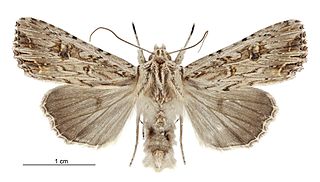
Ichneutica lignana is a moth of the family Noctuidae. It is endemic to New Zealand. This species is found on the Three Kings Islands as well as the North, South and Stewart Islands. This species lives in a variety of habitats including coastal areas, tussock grasslands, shrublands, and native forest, at a range of altitudes from sea level to over 1300 m. I. lignana is quite distinctive in appearance with its dark markings on the abdomen and forewings although it is possible to confuse Ichneutica morosa, Meterana pansicolor and Meterana pascoi with this species. Adults are on the wing throughout the year in the northern parts of the New Zealand but are restricted to the months of October to April in the more southern parts of the country.

Ichneutica insignis is a moth of the family Noctuidae. It is endemic to New Zealand. This species is found throughout New Zealand, although it appears to be scarce in inland sites of tussock grasslands. The adults are on the wing throughout the year. It is a variable species and as such can be easily confused with I. skelloni and I. plena. The larvae of this species have been recorded as feeding on Trifolium pratense.
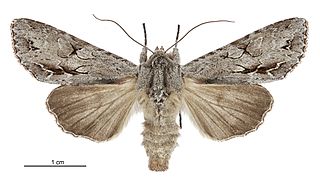
Ichneutica ustistriga is a moth of the family Noctuidae. It is endemic to New Zealand and can be found from the Three Kings Islands to Stewart Island. This species lives in a wide variety of habitats including domestic gardens, horticultural areas, orchards, native and exotic grasslands, as well as native forest. The larvae eat a variety of herbaceous plants. Recorded food plants include Muehlenbeckia australis, Muehlenbeckia complexa, Olearia hectorii, and Plantago lanceolata. This moth has a mauvish grey wing colour and is unlikely to be confused with other species as the patterns on its forewing are distinctive. This species is on the wing throughout the year and is attracted to both sugar and light traps. Adult moths can be found at rest on fences and tree trunks during the day.

Ichneutica semivittata is a moth of the family Noctuidae. It is endemic to New Zealand. It can be found from the Three King Islands down to Stewart Island. The similar species I. sulcana can be distinguished from I. semivittata as the former is much larger, has a darker hindwing and abdomen and has only one to three spots located behind the middle of the forewing in comparison to the 8 or 9 of I. semivittata. This species lives in a variety of habitats from open grasslands to clearings in forest and at a range of altitudes from the sea level to the alpine zone. Larval host species include Juncus procera, Carex secta as well as on tussock grasses such as Poa cita, P. colensoi and Festuca novae-zelandiae. Adults of this species are on the wing from August to April and are attracted to light.

Ichneutica omoplaca is a moth of the family Noctuidae. It is endemic to New Zealand. It is widespread from the Bay of Plenty in the North Island down to Southland in the South Island. Specimens have also been collected from the Auckland Islands. It lives in a variety of habitats including beech forest clearings and tussock grasslands. This species has been recorded that some of the larval hosts of this species include Poa cita, Dactylis glomerata and it has been reared on Plantago lanceolata. The larva is undescribed but pupae have been found in a pine plantation in soil under weeds. Adults of this species are on the wing from October to March. The adult moths are variable in appearance but the diagnostic feature is the pale ochreous to white colouring between the basal streak and the costa which contrasts with the ground colour of the forewing.

Ichneutica pagaia is a moth of the family Noctuidae. I. pagaia is endemic to New Zealand and can only be found on the Snares Islands. This species is unlikely to be confused with moths with a similar appearance as it is the only noctuid found in the Snares Islands. Its preferred habitat is tussock grasslands and the hosts for its larvae are likely Poa astonii and Poa tennantiana. Adults of this species are on the wing from November to February.

Ichneutica petrograpta is a moth of the family Noctuidae. This species is endemic to New Zealand where it is found in the southwest districts of the South Island, including Westland, Otago Lakes and Fiordland. It is very similar in appearance to I. mutans. It inhabits tussock and shrubland in the alpine to subalpine zones. Adults of I. petrograpta are on the wing from December to February and are attracted to sugar traps. The life history of this species is unknown as are the host species of its larvae.
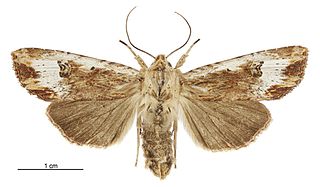
Ichneutica rubescens is a moth of the family Noctuidae. It is endemic to New Zealand. This species can be found locally in the North Island but is widespread throughout the South Island and is present on both Stewart Island and the Auckland Islands. I. rubescens has a round or oval mark near the centre of the forewing that encloses a dot. This is diagnostic of this species. I. rubescens inhabits tussock grasslands, beech as well as podocarp forests. Larval hosts are likely herbaceous plants such as grasses and herbs and larvae have been reared on Gunnera prorepens. Adults of this species are on the wing from December to April and are attracted to light.

Ichneutica scutata is a moth of the family Noctuidae. It is endemic to New Zealand. This species can be found in the southern parts of the North Island as well as the eastern parts of the South Island. It is similar in appearance to I. insignis and I. skelloni but can be distinguished as I. scutata is much paler in appearance. It is likely this species inhabits lowland tussock grasslands as well as coastal dunes although it is not common in inland tussock grasslands. The larvae feed on a variety of herbaceous plants such as Plantago and Convolvulus species, Plagianthus divaricatus. It pupates on soil near its host plants. The adults are on the wing from late March to July.
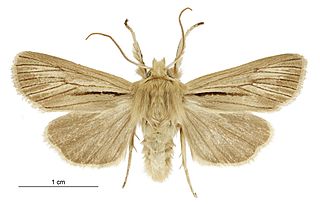
Ichneutica acontistis is a moth of the family Noctuidae. It is endemic to New Zealand and is found only in the South Island, mainly on the eastern side although not in the Nelson district. This species is similar in appearance to I. paraxysta,I. stulta and I. toroneura. I. acontistis is unlikely to be confused with I. paraxysta as the later is only found in the North Island. I. acontistis can be distinguished from I. stulta as the latter species has a strongly curved forewing edge where as I. acontistis' is straight. I. acontistis can be distinguished from I. toroneura as the former has a dark stroke of colour starting from the base of the forewing that I. toroneura lacks. I. acontistis inhabits tussock grasslands and the larvae of this species feed on species of grass found in the genera Poa, Elymus and Rytidosperma. It pupates under rocks and adults are on the wing from September to January. I. acontistis are attracted to light.

Ichneutica atristriga is a moth of the family Noctuidae. It is endemic to New Zealand and is found through out the North, South and Stewart Islands. The larval hosts likely include tussock grasses included Poa cita, P. colensoi and Festuca novae-zelandiae. Larvae have been reared on species in the genera Bromus and Festuca. The adults of this species are on the wing from November to May. I. atristriga can possibly be confused with the smaller species I. propria. However I. atristriga has thorax and forewings that have a pinkish tinge and I. propria has a dark streak on the discal part of the forewing which I. atristriga lacks. A study has indicated that the population numbers of this species have decreased.
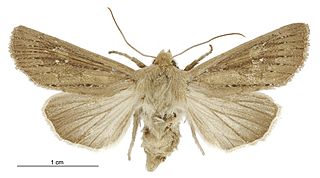
Ichneutica phaula is a moth of the family Noctuidae. It is endemic to New Zealand. It is found only in the South Island in the Nelson district, the eastern side of the South Island and Stewart Island. I. phaula inhabits tussock grasslands and coastal sand dunes. Host species include Ficinia spiralis, Ammophila arenaria, Poa cita and other "tussock grasses". The adults of this species are on the wing from October to December and are attracted to sugar traps. I. phaula is similar in appearance to both I. micastra, with whom it does not share a range, and I. sapiens which differs from I. phaula as I. sapiens is darker and has a more reddish tinge.

Ichneutica propria is a moth of the family Noctuidae. It is endemic to New Zealand. This species is only known from Tongariro National Park and Pureora Forest in the North Island but is widespread in the South Island. I. propria might be confused with faded I. atristriga, however the later species lacks the distinctive marking on the prothorax nor does it have the black mark running through the middle of the forewing. It is very common and widespread in montane to alpine grassland areas. Although the larvae have yet to be described, they have been reared on Poa cita and Festuca novae-zelandiae and are known to feed on introduced grass species. The adults of this species are on the wing from December to mid May and are attracted to light.

Ichneutica toroneura is a moth of the family Noctuidae. It is endemic to New Zealand. This species is similar to I. unica but can be distinguished from that species by the uniform black vein markings on the forewings of I. toroneura. It is also similar in appearance to I. acontistis but the base of the forewings of I. toroneura lack the dark stripe that can be found on the forewings of I. acontistis. The males of I. toroneura have longer pectinations on their antennae. I. toroneura is found in the centre of southern South Island in the tussock grasslands of Central Otago and the Mackenzie Basin. Larvae feed on tussock grasses Poa cita and Festuca novae-zelandiae. Adults are on the wing from November to January.

Ichneutica paraxysta is a moth of the family Noctuidae. It is endemic to New Zealand. This species is very similar in appearance to its close relative I. acontistis but as the range of the two species do not overlap this is unlikely to cause confusion. I. paraxysta is only found in the North Island at the subalpine zones in the Mount Taranaki region and at Mount Ruapehu. It prefers tussock grassland and shrubland habitat. The life history of this species is unknown as are the host species of its larvae however it has been hypothesised that the larval host plants are species in the genera of Poa and Festuca.

Ichneutica cuneata is a moth in the family Noctuidae. It is endemic to New Zealand. I. cuneata is found in and around the Tongariro National Park in the North Island and throughout the South Island. Specimens found in Tongariro National Park tend to be darker in appearance than South Island specimens but as their colour is variable, and antennae and genitalia of both species are consistent, they are not now regarded as a separate species. I. cuneata inhabits tussock grasslands and shrublands in alpine and subalpine zones. The adults are on the wing from December to April and can be found flying during the day. The life history of I. cuneata is unknown as are the specific host species of its larvae. However larvae of I. cuneata are said to feed on herbaceous plants. The adults of this species also pollinate native species such as Myosotis macrantha.

Ichneutica paracausta is a moth of the family Noctuidae. This species is endemic to New Zealand. It is found locally in the central North Island, is widespread in the South Island and can also be found in Stewart Island. I. paracausta is variable in colour, but as it has a distinctive black streak on its forewing as well as a wing pattern that is characteristic, I. paracausta is unlikely to be confused with other species. It is present on the North Island volcanic plateau as well as Little Bush Reserve in Hawkes Bay in the North Island as well as in tussock grassland, alpine and subalpine shrubland and in alpine forest. Larvae have been recorded as feeding on grasses, a pupa has been found in a cocoon under the bark of a tree and adult moths are on the wing from October to January.

Ichneutica infensa is a moth of the family Noctuidae. This species is endemic to New Zealand. It is found throughout the North and South Islands but appears to be rarely seen or collected in the north and west parts of the North Island. As at 2019 the northern limit to the range of this species is Titirangi. I. infensa inhabits tussock grasslands and native forest. Larvae are nocturnal and its host plants are in the genus Carex including Carex solandri. Larvae have also been raised on Bromus catharticus. Adults of this species are on the wing from late October to February. Adults are narrow winged with patterns on the forewings that are relatively distinctive. However this species can possibly be confused with I. inscripta.























